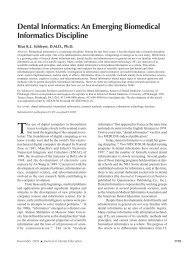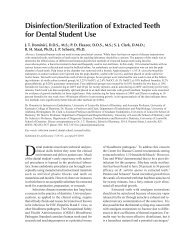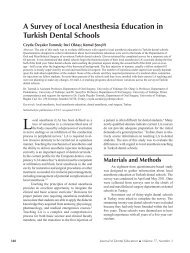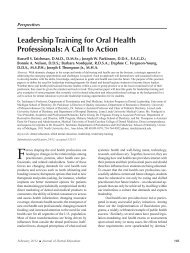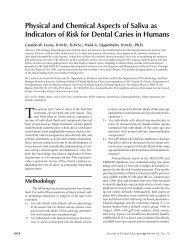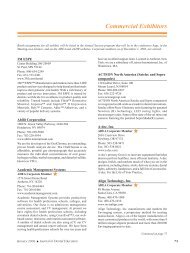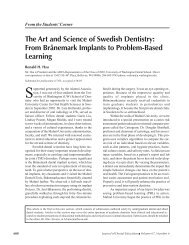Experience with Virtual Reality-Based Technology in Teaching ...
Experience with Virtual Reality-Based Technology in Teaching ...
Experience with Virtual Reality-Based Technology in Teaching ...
You also want an ePaper? Increase the reach of your titles
YUMPU automatically turns print PDFs into web optimized ePapers that Google loves.
par<strong>in</strong>g Class I preparations compared to the experimental<br />
students who spent an average of 3.69 hours<br />
(Table 1, p=0.07). Experimental students asked for<br />
evaluation more times (6.52 evaluation per hour of<br />
practice) than control students (3.21 evaluations per<br />
hour of practice) (Table 1, p=0.08). The experimental<br />
students prepared significantly more teeth per hour<br />
(average of 3.8 preparations/hr) than the control students<br />
(average of 1.6 preparations/hr) and not surpris<strong>in</strong>gly<br />
used more teeth (average of 11.71 versus<br />
6.57 for control, p=0.02). This emphasizes a higher<br />
efficiency <strong>in</strong> prepar<strong>in</strong>g teeth us<strong>in</strong>g VRBT. The results<br />
of the Class I practical exam<strong>in</strong>ation were slightly<br />
higher for the experimental group (72.6 percent versus<br />
61.9 percent) but were not statistically significant<br />
(p=0.23, Table 2).<br />
In Study 2, which conta<strong>in</strong>ed fourteen students<br />
<strong>in</strong> each group (control and experimental), similar<br />
results were found <strong>with</strong> control students<br />
spend<strong>in</strong>g 14.2 hours practic<strong>in</strong>g<br />
Class I and II preparations before<br />
the practical as compared to<br />
the experimental group spend<strong>in</strong>g<br />
8.2 hours practic<strong>in</strong>g (Table 1).<br />
Control students <strong>in</strong> Study 2 prepared<br />
2.1 preparations per hour<br />
compared to the experimental<br />
group, which prepared 3.4 preparations<br />
per hour. The control group<br />
requested an average of 1.99 evaluations<br />
per hour of practice compared<br />
to the experimental group,<br />
which requested 6.18 evaluations<br />
per hour (Table 1). The most obvious<br />
reason for this difference may<br />
be the ease of request<strong>in</strong>g evaluations<br />
from the computer compared<br />
<strong>with</strong> the difficulty or reluctance of<br />
a student to attract the attention of<br />
a faculty member for evaluation.<br />
These evaluations were both formative<br />
and summative. The fact,<br />
however, that the students requested<br />
evaluations this frequently<br />
suggests that the students <strong>in</strong> this<br />
study viewed frequent feedback as<br />
helpful to learn<strong>in</strong>g. This frequency<br />
of evaluations would not be feasible<br />
<strong>in</strong> a traditional laboratory<br />
s<strong>in</strong>ce it would require a faculty<br />
member supervis<strong>in</strong>g twelve students<br />
to give a complete evaluation<br />
of a preparation about every forty-five seconds. Recent<br />
experience <strong>with</strong> VRBT us<strong>in</strong>g an entire class has<br />
shown that students need to be weaned from the availability<br />
of <strong>in</strong>stant evaluation at some po<strong>in</strong>t <strong>in</strong> order to<br />
develop the ability to self-assess us<strong>in</strong>g <strong>in</strong>struments<br />
always available such as a probe and condenser.<br />
In Study 2, students <strong>in</strong> both control and experimental<br />
groups completed two practicals that were<br />
graded by one faculty member <strong>in</strong> a bl<strong>in</strong>ded manner.<br />
Control students scored 79.3 percent and 80.9 percent<br />
on the Class I and Class II practicals respectively,<br />
while the experimental students scored lower<br />
than control <strong>with</strong> 72.0 percent <strong>in</strong> the Class I and similar<br />
to control <strong>in</strong> the more difficult Class II at 79.7<br />
percent (Table 2). The two groups’ f<strong>in</strong>al overall<br />
grades <strong>in</strong> the course (laboratory portion only) were<br />
very similar, <strong>with</strong> the control students earn<strong>in</strong>g<br />
86.0 and the experimental groups averag<strong>in</strong>g 86.7<br />
Table 1. Comparison of time and evaluations requested<br />
Groups Time Spent Practic<strong>in</strong>g Evaluations Requested<br />
Per Hour of Practice<br />
Control Study 1 6.71 hrs (Class I ) 3.21<br />
Experimental Study 1 3.69 hrs (Class I) 6.52<br />
Control Study 2 14.2 hrs (Class I & II) 1.99<br />
Experimental Study 2 8.2 hrs (Class I & II) 6.18<br />
Comb<strong>in</strong>ed groups (Studies 1 & 2)<br />
Control groups’ averages 20.1 hrs 2.41<br />
Experimental groups’ averages 11.8 hrs 6.29<br />
Students recorded <strong>in</strong> log books the hours they spent practic<strong>in</strong>g before the practical<br />
exams and the number of times they requested expert evaluation. For control<br />
students, this was the number of times they requested feedback from an <strong>in</strong>structor;<br />
for experimental students, it was the number of times they requested evaluation<br />
from the unit. Study 1 had eight students per group; Study 2 had fourteen students<br />
per group.<br />
Table 2. Comparison of practical exam<strong>in</strong>ations and f<strong>in</strong>al course grades<br />
Group Practical Exam<strong>in</strong>ations F<strong>in</strong>al Course Grade<br />
Class I Class II<br />
Control Study 1 61.9 89.3<br />
Experimental Study 1 72.6 87.8<br />
Control Study 2 79.3 80.9 86.0<br />
Experimental Study 2 72.0 79.7 86.7<br />
Comb<strong>in</strong>ed averages (Studies 1 & 2)<br />
Control groups’ averages 70.6 80.9 87.7<br />
Experimental groups’ averages 72.3 79.7 87.3<br />
Results of practical exam<strong>in</strong>ations of procedures evaluated by one faculty member<br />
<strong>in</strong> a bl<strong>in</strong>ded manner. Study 1 <strong>in</strong>volved eight students per group; Study 2 <strong>in</strong>volved<br />
fourteen students per group.<br />
December 2004 ■ Journal of Dental Education 1261



